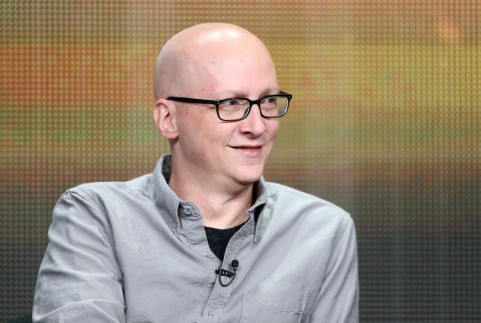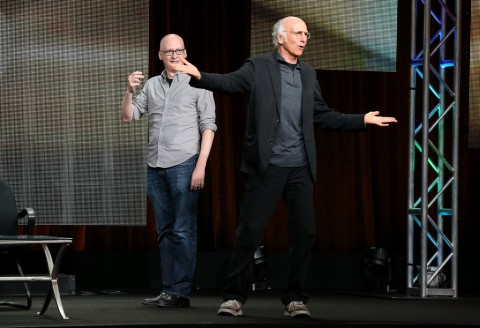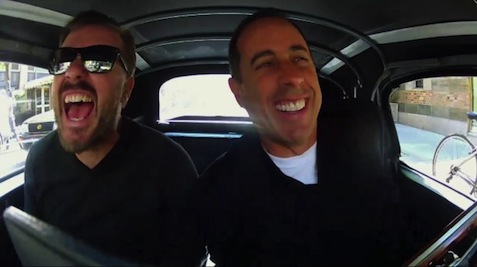The Light from the TV Shows: A Chat with Greg Mottola (“Clear History”)
Greg Mottola first came to prominence as the director of the indie comedy “The Daytrippers,” but he began a much quicker rise in mainstream recognition when he helmed the comedies “Superbad” and “Adventureland.” Currently, Mottola is making the rounds to support his work as the director of Larry David’s new HBO movie, “Clear History,” but he’s not entirely confident if the word “director” really sums up his efforts on the film. Bullz-Eye chatted with Mottola during the TCA press tour, and we talked about how surprisingly easy David is to work with, how he came to appear in a couple of Woody Allen films as an actor, and what a hassle – and what fun – it was to make “Paul.”

Bullz-Eye: So directing Larry David has got to be at least somewhat of a challenge.
Greg Mottola: Um…
BE: I’m not saying good or bad, just…challenging.
GM: It’s… Well, I mean, the process was so specific. I don’t even know if my job title should be called “director” on this movie. [Laughs.] “Associate collaborator” is probably closer to it. But that’s the way it should be. I’m not sure if, in the press notes, they talk so much about how we made it, but essentially it’s the same way Larry does “Curb Your Enthusiasm,” with some key differences. But Larry writes a script-ment, they call it, so this was about 35 pages of paragraphs of what happens in this scene, with an occasional line of dialogue or joke that Larry or his co-writers thought, “Oh, we should definitely get that in.” So they write that in, but, really, no other dialogue.
And we get to the set, we walk through the scene, and we’ll just sort of block it very generally. Like, “You’re gonna enter from that door, you’re gonna be sitting here, you’re gonna come over here, talk about this, you’re gonna leave.” Y’know, just sort of walk through all the little bits of blocking, but never rehearse it at all. So the first time anyone is acting, the cameras are rolling. And it’s usually two cameras, sometimes three if we can squeeze another one in there. And Larry by and large never does the same thing twice. [Laughs.] So as a director, you’re constantly strategizing, “Okay, we did that one time, I’d like to try and get something like that line, maybe in a tighter size, so…let’s switch lenses right now while we’re in the zone, and we’ll swap back and do wide shots again.” So you’re constantly just sort of improvising the directing style as everyone’s improvising the lines.

So directing Larry is just sort of endless conferences between takes about, “We’d like this from that, we didn’t like that,” just sort of honing in on what worked, sometimes stopping entirely and saying, “This doesn’t work at all, let’s start from scratch and just approach it completely differently and do a different version of the scene.” And that happened a few times. We’d have two completely different versions of the same scene…and usually the one that ends up in the movie is the second one. You know, the one thing about Larry is that he’s an absolute pleasure to work with. Despite his sort of screen persona and his point of view about human nature, which—between “Seinfeld” and “Curb”—is pretty clear… [Laughs.] He’s a really happy guy! He’s a guy who walks around whistling and practicing his golf swing. He’s, like, in a good mood 99% of the time. So it’s great to work with him.
BE: I…can’t really wrap my head around that.
GM: [Laughs.] It is hard to believe.
You can follow us on Twitter and Facebook for content updates. Also, sign up for our email list for weekly updates and check us out on Google+ as well.
Posted in: Entertainment, Interviews, Movies, News, Television
Tags: Celebrity, Clear History, Curb Your Enthusiasm, Doug McGrath, Greg Mottola, HBO, Hollywood Enmding, Jon Hamm, Larry David, Louis C.K., Melanie Griffith, Paul, Philip Baker Hall, Seinfeld, Sidney Lumet, Simon Pegg, The Daytrippers, The Light from the TV Shows, W.C. Fields, Will Harris, Woody Allen












